
The Labrador Retriever has been the most popular breed in America for 29 years running, many people know and love this breed!
Recently, the terms English Lab and “American” Labrador have been appearing more and more in dog networks.
But, what is the difference between these two dogs? Are they the same breed? What does it truly mean to be an English Labrador?
To answer that question (and many others), keep on reading our ultimate guide to this breed.
TABLE OF CONTENTS
English Lab Breed Origin
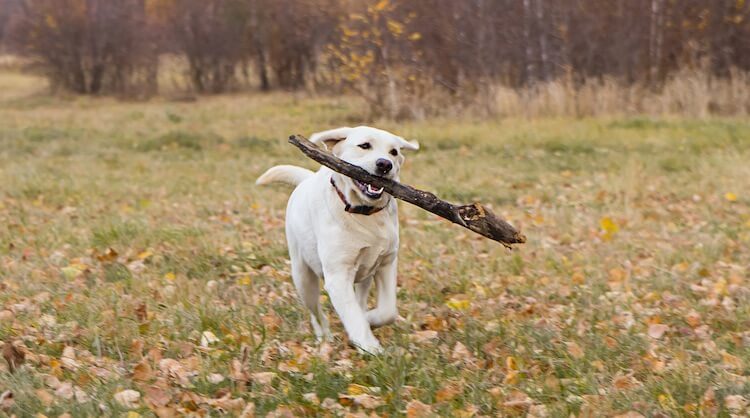
The term Labrador was first used in England towards the end of the 19th Century.
Originally called St John’s Dog or the Lesser Newfoundland, these canines were brought to England from Canada, where they had been used by fishermen to help haul in their nets.
Instantly popular in the UK, they were registered by the Kennel Club in 1903 and the American Kennel Club in 1917.
Nowadays, you are much less likely to find these dogs at a gun range (or hauling in nets at a dockyard), instead, you are much more likely to spot one bounding through the fields with their family or assisting a disabled person as an assistance dog!
English Lab vs. American Labrador – What Is The Difference?
Generally speaking, it is commonly understood that Labradors bred from working lines are American Labradors, whereas Labradors bred for the show ring are generally called English Labrador Retrievers.
The naming system comes from where the breed’s bloodlines are more common:
- Show bloodlines are more common in the UK
- Working bloodlines are more common in the USA
Despite the anatomical differences (discussed below), they are still considered to be the same breed.
These terms are not strict categories, instead they are more useful guidelines to describe the bloodline of the Labrador in question.
| Size | 21.5 to 22.5 inches |
| Weight | 70 to 80lb (males) and 60 to 70lb (females) |
| Lifespan | 10 to 12 years |
| Breed Type | Gundog Group |
| Purpose | Retrieval |
| Suitable For | Active Families, Seniors And Singles |
| Color Variations | Golden, Chocolate, Black, Silver |
| Temperament | Friendly, Loyal, Caring, Playful and Fun |
| Other Names | English Labrador Retriever |
English Lab Puppies

On average, a Lab will have eight puppies in a litter, but the number can vary between six and twelve.
Due to their popularity, English Lab puppies average between $600 and $1,200 USD.
At eight weeks old (when they are ready to bring home) they will need to be introduced to lots of sights, sounds and smells to create a well socialized puppy.
Below is an approximate growth chart detailing the physical growth of these little pooches.
This is an approximate weight, so do not be too surprised if your dog is a few pounds above or below average.
However, if your dog is massively over or underweight, this will warrant a trip to the vets for a full health check.
| 3 | 20 |
| 6 | 55 |
| 9 | 62 |
| 12 | 70 |
English Labrador Temperament
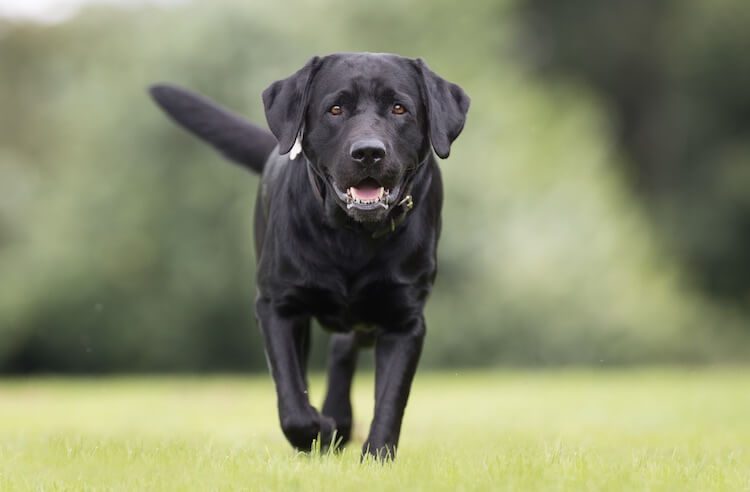
The English Labrador is not known to be a particularly barky dog, instead they only bark to alert their owner to an odd noise or a new person in the environment.
While Labradors enjoy a good game of chase and fetch every day, it is unlikely they will disappear off into the sunset chasing a squirrel or a cat.
Instead, they are much more likely to have their nose to the ground sniffing out the food at a picnic across the park!
This breed is often noted for their low level of aggression. Consequently, they are not known to be good guard or watch dogs, as they are more likely to cuddle up with an intruder than scare them off!
Known for their loyal and dedicated nature, this can occasionally lead them to struggling with separation related issues.
Consequently, training for this should begin as soon as the puppy is brought home, by leaving your puppy for very short periods (no longer than 1 minute) and then returning.
This will teach your English Lab that you always come home, and good things come with you.
Personality
Labrador Retrieves are world-renowned for their personality, affectionate and loving nature, these adorable dogs captivate everyone they meet.
English Labs are noted for their mild-mannered personalities.
However, don’t mistake this for a lack of energy, these dogs get the zoomies daily and require plenty of exercise!
After a good exercise, they have an easy-going aura that captivates those around them with their relaxed nature calming their family.
Provided you can keep up with their exercise regime, and give them the space that they need, these kind-hearted dogs are suitable for people from all walks of life.
Compatibility with Families
English Labs are known for being the ultimate family dog!
With their show bloodline, provided they are well socialized, they will get on well with all members of the family.
If introduced at a young age, they also can get on well with other dogs, cats, rabbits, or any other pet your family may have!
Be sure to supervise introductions in the beginning to ensure that both pets are behaving appropriately and slowly integrate the two.
Although English Labrador Retrievers are very well known for their patience, it is important to remember that all dogs have a breaking point.
So, whilst it is crucial to teach your pooch how to play with your children, it is just as key that you teach your children how to play with your canine.
English Lab Appearance
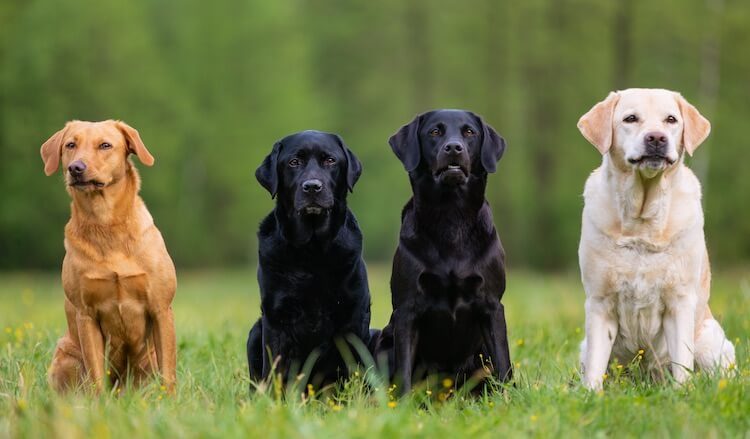
These dogs are medium sized, stocky and athletic in appearance.
This breed is noted for what is described as their “otters tail”, a medium length, thick tail which was originally used for propelling them through the water like a rudder.
Their coat is also an iconic feature of the breed (more on this below).
Size
While American Labradors are slightly larger (21.5 to 24.5 inches), English Labs have a slightly stockier build, standing between 21.5 and 22.5 inches high (regardless of sex).
In terms of weight, females tend to weigh slightly less between 60 and 70lb and males tend to weigh between 70 and 80lb.
Color
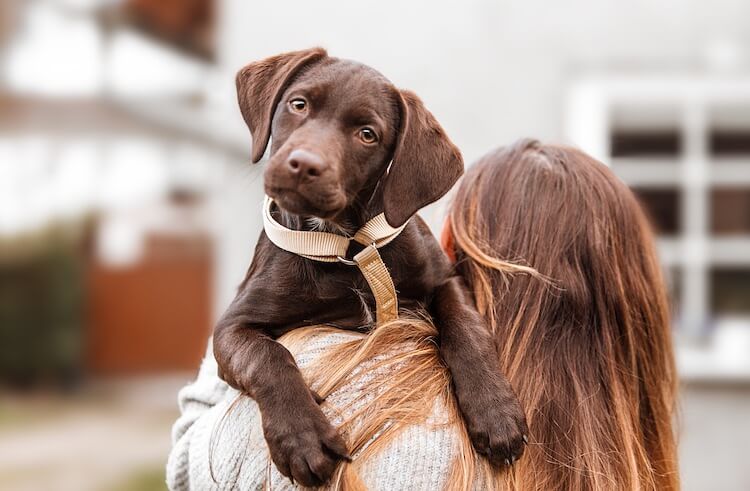
From Adobe Stock
Acceptable colors for this breed, per the AKC standard, are:
- Black
- Chocolate
- Yellow
However in rare cases your dog could be silver like a silver lab.
It is not acceptable for any of these dogs to be multi or tri-colored, instead they should be one solid color.
Coat
The English Lab is easily identifiable by their short, stiff, dense coat which is weather resistant.
Although some owners indicate otherwise, this breed should have a single coat.
Grooming
English Labs are a very high shedding breed and as a result they are not suitable for people with dog allergies.
These high shedding single coats will need grooming almost daily, especially during seasonal coat blow outs.
Try using a rubber brush in circular motions to collect not only all the hair but to give your dog a nice massage!
These dogs are known to have quite sensitive skin, so try only bathing when absolutely necessary. When bathing, use a medicated shampoo to try to avoid any discomfort.
Ensure that your dog is completely dry, any water trapped in their thick coat can cause the skin to dry out.
Unlike other breeds, Labs’ coats do not need to be clipped. However, they do need regular ear checks and their nails trimmed regularly.
Dog Breed Care Guide
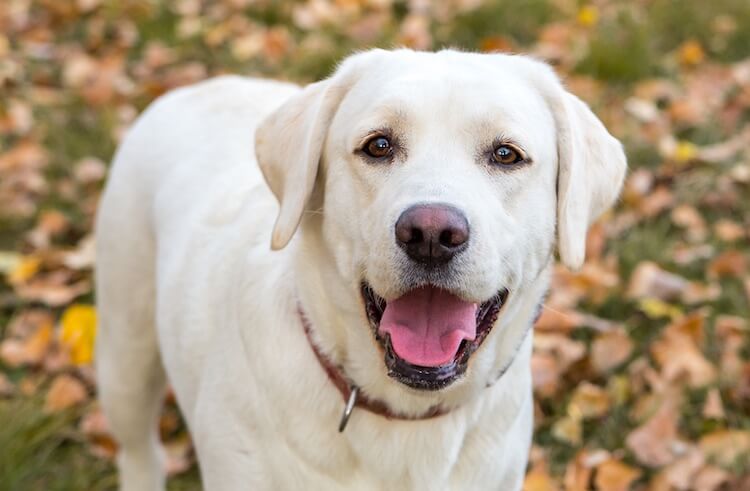
From Adobe Stock
English Labrador Retrievers do best in homes that are large and spacious (ideally with a garden).
They are suitable for families of all shapes and sizes but need an owner or owners who can keep up with their active lifestyle.
Food and Dietary Requirements
| Daily Food Consumption | |
|---|---|
| Guide | 1,000 calories |
| Cups of Kibble | From Adobe Stock |
Labradors are known to be very unfussy eaters, if it hits the floor, your English Labrador will have gobbled it up before you even saw it go down.
For their diet, these canines need a high quality protein source.
On average, this dog will need to eat 2.5 cups of food/kibble each day; ideally, this should be split into two or three meals, to space out their food intake.
This breed is a speedy eater, which can case health issues, such as bloat, consequently owners should feed their English Labs smaller meals – ideally in a slow down bowl or puzzle feeder.
Exercise Requirements
| Daily Exercise Requirements | |
|---|---|
| Minutes | 60 minutes |
| Activity Level | From Adobe Stock |
These dogs need 60 minutes of aerobic exercise, even if it takes a little convincing to get them outside.
Ideally, this sixty-minute exercise period should be split into two walks each day (thirty minutes each). Known to be a very playful breed, you can also play fetch to help burn off some energy.
English Labrador Retrievers tend to be a little lazier than their working line American cousins.
Once out and about, Labs are known to have excellent recall when trained:
- If properly trained, owners shouldn’t have any trouble getting their dog back
- If not properly taught, Labradors are known to follow their noses (and stomachs) and are likely to wander off
Training
English Labs are highly intelligent and trainable dogs.
It is not uncommon to find these canines working as a service dogs, helping blind people among other life changing professions.
These clever dogs are very food and play motivated, making them very easy to train.
They have a big heart, and consequently they do not do well with punishment.
When looking to train a Lab, always use positive reinforcement and steer clear of any training methods that involve punishment.
Health Problems
A survey conducted by the Kennel Club indicates that the most common causes of death for this breed is cancer, cardiac issues and old age.
The biggest, and most major, health concern for an English Labrador Retriever is hip and elbow dysplasia.
This is believed to be an inherited condition, and consequently it is possible to test for this in the parents before purchasing a puppy.
However, if you are planning to adopt, this may not be a viable option.
Epilepsy is also a relatively common condition in this canine. Although this may appear scary, modern veterinary medicine makes managing a dog with epilepsy relatively easy.
On average, a English Lab will live between 10 and 12 years!
Summary
An English Lab is a modern name for a dog (of the Labrador breed classification) that is from a show bloodline.
They are named this way because they are more common in England than they are in America.
Slightly heavier set than their American cousins, English Labradors are loving and loyal dogs that will find the way into the heart of any owner or owners.
Recently got a puppy, but you are unsure of what to call him? Here’s our list of suggested Labrador names.
Let us know your thoughts on this beautiful breed below.



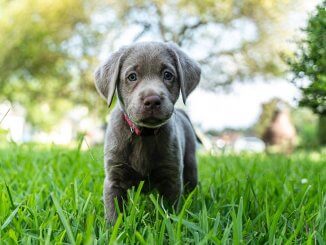
Be the first to comment